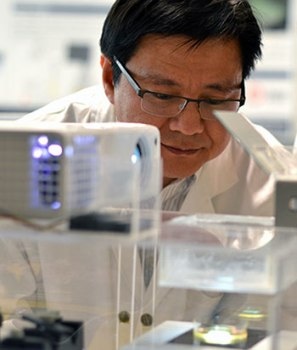Sep 15 2017
Researchers at UBC’s Okanagan campus have created an innovative bio-ink that may support an inexpensive and a more efficient fabrication of human organs and tissues.
 UBC Okanagan’s Keekyoung Kim has great hopes for the bio-ink he is researching in his lab. Credit: The University of British Columbia
UBC Okanagan’s Keekyoung Kim has great hopes for the bio-ink he is researching in his lab. Credit: The University of British Columbia
Keekyoung Kim, an assistant professor at UBC Okanagan’s School of Engineering, says that this development can speed up advances in regenerative medicine.
Scientists are creating bio-material products that function together with living cells with the help of techniques like 3D printing. These products are made using several biomaterials including a hydrogel known as gelatin methacrylate (GelMA) that can act as a building block in bio-printing. Although made of living cells, this kind of bio-material, known as bio-ink, can be printed and molded into specific tissue or organ shapes.
The UBC team analyzed the biological and physical properties of three different GelMA hydrogels— cold-soluble gelatine, cold-water fish skin and porcine skin. They discovered that hydrogel made from cold-soluble gelatin (gelatin that dissolves without heat) was certainly the best performer and a strong candidate for future 3D organ printing.
A big drawback of conventional hydrogel is its thermal instability. Even small changes in temperature cause significant changes in its viscosity or thickness. This makes it problematic for many room temperature bio-fabrication systems, which are compatible with only a narrow range of hydrogel viscosities and which must generate products that are as uniform as possible if they are to function properly.
Kim
Kim’s team produced two new hydrogels—one from cold-soluble gelatine and another from fish skin. The team then compared their properties to those of porcine skin GelMA. Cold-soluble GelMA was the top overall performer despite fish skin GelMA having some benefits. It could not only form healthy tissue scaffolds, enabling cells to effectively grow and adhere to it, but was also thermally stable at room temperature.
The UBC team also showed that cold-soluble GelMA generates consistently uniform droplets at temperatures, thus rendering it an exceptional option for use in 3D bio-printing.
We hope this new bio-ink will help researchers create improved artificial organs and lead to the development of better drugs, tissue engineering and regenerative therapies. The next step is to investigate whether or not cold-soluble GelMA-based tissue scaffolds are can be used long-term both in the laboratory and in real-world transplants.
Kim
Cold-soluble gelatin is three times cheaper than porcine skin gelatin, and is used mainly in culinary applications.
Recently, this study was published in the August issue of Biofabrication.